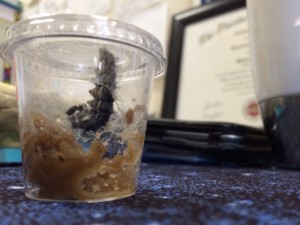Tag Archives: Nonfiction
It’s Chrysalis Time!
Yesterday, I snapped a quick picture of our caterpillar, Pablo Jr. It looked to me that he was getting ready to begin making his chrysalis. Today when I got to school, he was already in his chrysalis preparing to turn into a butterfly! I apologize for the bad pictures, but I didn’t want to move him while he was in metamorphosis!
Below, you can see the metamorphosis process sped up! Today, we will be reading and exploring how caterpillars, like Pablo Jr., make this big change!
The Sheep are Making a Comeback!
As we continue studying current events this week we are going to look deeper into the text features that help us understand what we’re reading. Like we’ve learned before, text features are anything other than the main paragraphs of the text, that help us better understand the author’s intended message. Today, we are going to read a Newsela.com article on the Bighorn sheep in California. These sheep had almost become extinct and only 105 were left. Now there are 500 sheep! Read the article to discover how scientists helped save the Bighorn sheep!
The article comes with a great map to help you understand where these sheep are located. Study the map and see what you notice. Is there a key or legend to help you out? Do the different colors and shadings mean anything? Is it important to read the text on the map as well?
Today, as you read from a Scholastic News magazine of your choice, notice how the text features help you better understand the text!
What if you couldn’t go to school?
On my favorite nonfiction reading for kids website, Newsela.com, there is an interesting article on children in Afghanistan who can’t afford to go to school. Read the article and let me know what you think. Can you imagine not being able to go to school? How would that change your life?
Shukriya, 8, sells toilet paper in downtown Kabul, Afghanistan. Although child labor is illegal in the country, it is still around today, due to a lack of enforcement and the need of many families to have as many members earning income as possible.
Back to Fiction!
We have enjoyed some amazing nonfiction books this school year (hey, there’s one of our prefixes, “non” means not!) We read The Interactive Biography of Martin Luther King Jr., Different Like Coco, and The Tree Lady. We’ve also read a plethora of books on all sorts of nonfiction topics, from porcupines to escape artists!
On Monday, we began our new read aloud book The Miraculous Journey of Edward Tulane, by Kate DiCamillo. This is one of my favorite books and it holds a special place in my heart. Every time I read this book to my students, they point out something new and interesting about the characters. You all did a marvelous job of quickly realizing that Edward is a selfish rabbit. We said he has a big ego!
Here is a sneak peek into our new read aloud. What predictions can you make based on the movie? Leave your predictions in a comment!

